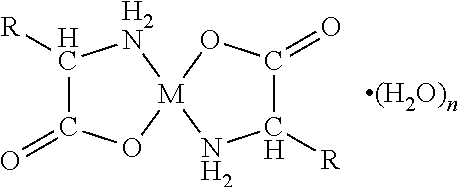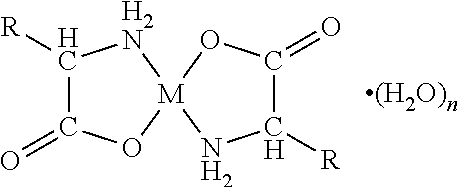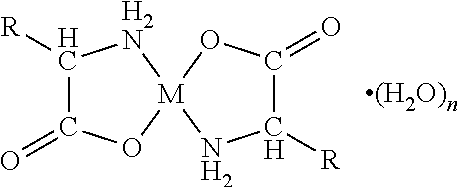Compositions and Formulations for the Treatment of Halitosis
a technology for halitosis and compositions, applied in the field of mouth hygiene compositions and formulations, can solve the problems of halitosis, halitosis, and halitosis in the mouth, and achieve the effects of reducing the effect of halitosis, and reducing the risk of halitosis
- Summary
- Abstract
- Description
- Claims
- Application Information
AI Technical Summary
Benefits of technology
Problems solved by technology
Method used
Image
Examples
example 1
[0069]The following examples illustrate the invention. Although the components and the specific ingredients are presented as being typical, various modifications within the scope of the invention can be derived based on what is disclosed in the above description.
[0070]A first embodiment of the present invention relates to an orally disintegrating composition comprising a chelate comprising a metal ion and a biologically acceptable amino acid and having the general formula
wherein M is the metal ion Zn2+ and the biologically acceptable amino acid is glycine.
[0071]In preferred embodiments of the resent invention the orally disintegrating composition has the following additional characteristics, either alone or in combination:[0072]an orally disintegrating composition wherein said chelate is controllably releasable into the oral cavity of a subject;[0073]an orally disintegrating composition, wherein the composition is based on one or more polyols, optionally in combination with starch, ...
example 2
[0085]6.8 g of zinc bisglycinate (10%), batch no. 1059888, i.e. corresponding to 6.8 mg zinc per tablet, was added directly into 49.04 g the commercially available carrier Advantol™ 300 (lot 121101344, prod. code 112-1234). No pre-treatment in the form of e.g. pulverizing, sieving or the like was required, neither for the chelate nor the carrier.
[0086]The mixture of zinc bisglycinate and Advantol™ 300 was dry blended and subsequently transferred to a manually operable tabletting apparatus (Diaf Type TWA4 Special) wherein the ODTs were compressed under pressure, i.e. approx. 1 metric ton. Tabletting was carried out under normal tabletting temperature, i.e. approx. 20-22° C., and humidity conditions, i.e. approx. 60% relative humidity (RF).
[0087]Manufacturing at temperatures of approx. 18-22° C. (room temperature) and a humidity of approx. 20% RF has turned out to provide an improved maintenance of the hardness of the ODT during manufacture and might be used for industrial scale manuf...
example 3
[0090]In a further embodiment of the present invention, tabletting was carried out under the same conditions as in EXAMPLE 2, albeit a rotary tablet press having the trade name FETTE™ 1200 was applied. The tabletting tool was lubricated by means of spraying magnesium stearate onto the punches and dies.
[0091]The resulting ODTs had excellent organoleptic properties.
PUM
| Property | Measurement | Unit |
|---|---|---|
| particle sizes | aaaaa | aaaaa |
| wt % | aaaaa | aaaaa |
| size | aaaaa | aaaaa |
Abstract
Description
Claims
Application Information
 Login to View More
Login to View More - R&D
- Intellectual Property
- Life Sciences
- Materials
- Tech Scout
- Unparalleled Data Quality
- Higher Quality Content
- 60% Fewer Hallucinations
Browse by: Latest US Patents, China's latest patents, Technical Efficacy Thesaurus, Application Domain, Technology Topic, Popular Technical Reports.
© 2025 PatSnap. All rights reserved.Legal|Privacy policy|Modern Slavery Act Transparency Statement|Sitemap|About US| Contact US: help@patsnap.com



